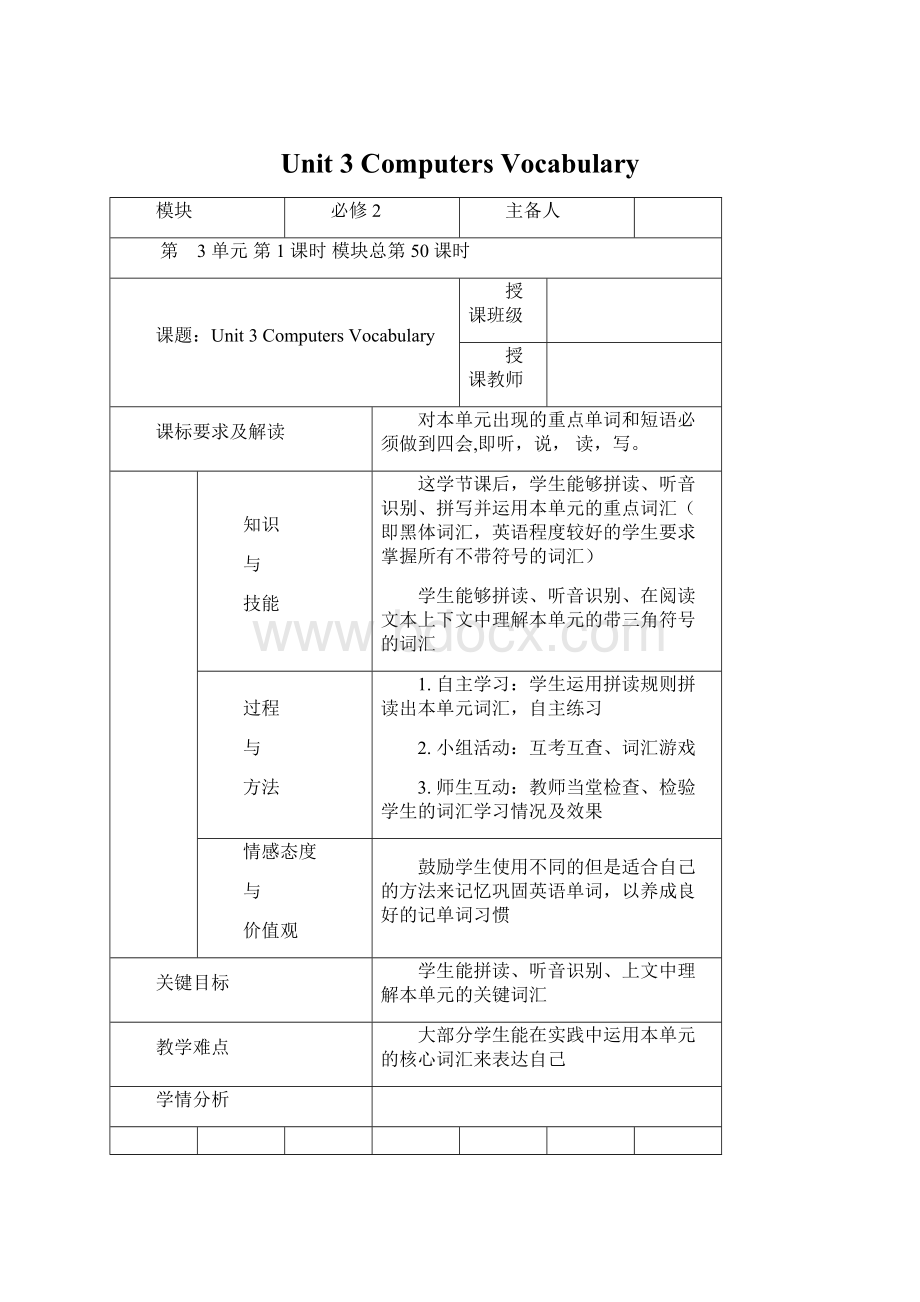Unit 3 Computers VocabularyWord文档格式.docx
《Unit 3 Computers VocabularyWord文档格式.docx》由会员分享,可在线阅读,更多相关《Unit 3 Computers VocabularyWord文档格式.docx(29页珍藏版)》请在冰豆网上搜索。

教师当堂检查、检验学生的词汇学习情况及效果
情感态度
价值观
鼓励学生使用不同的但是适合自己的方法来记忆巩固英语单词,以养成良好的记单词习惯
关键目标
学生能拼读、听音识别、上文中理解本单元的关键词汇
教学难点
大部分学生能在实践中运用本单元的核心词汇来表达自己
学情分析
二.教学过程
教学流程、知识呈现
个性化思考
Step1.pronunciation
1)Sspronouncethewordsandphrasesinunit3bythemselves.
2)Sschecktheirpronunciationinpairs.
3)Sslistenandrepeataftertherecord
4)Sscorrecttheirpronunciationbypracticing
5)TheteachercheckSs‘work
Step2.Wordformation
1)Ssworkingroupstofindoutsomeofthewords’formation.
eg:
solve(v.)-solution(n.)happy(adj.)-happiness(n.)
Person(n.)-personal(adj.)-personally(adv.)
2)Sssharetheirfindingswiththewholeclass
Step3Games
1)Sshave5minutestomemorizeasmanywordsaspossible
2)Ssworkingroupstocheckoneachothertofindoutwhocanmemorizethemostwordsintheirways.
Step4.Practice
1.Ssfinishtheexercises1-3onPage20inthetextbook.
2.ChecktheirworkbyaskingsomeofthemtowritetheanswersontheBborreporttotheclassorally.
Step5Homework
Ssfinishtheexercises1-2onPage56intheworkbook
___________________
__________________
三.教学反思
一.教学准备
郭桂红
第 3单元第2课时模块总第51课时
Unit3ComputersReadingforInformation
通过快速浏览课文了解文章的主要信息,这种技能能帮助学生提高理解和捕捉文章主要信息的能力;
通过跳读抓住Comprehending部分所需要的事实细节,训练学生快速获取所需信息的能力。
教
学
目
标
1.学生能够了解更多计算机的发展史以及其在各领域的运用。
2.学生能够使用SKimming这种阅读技能去快速抓住文章的主旨以及各段的主要内容
3.学生能够运用Scanning这种阅读技能在文中获取所需的具体事实细节
方法
1.头脑风暴:
说出与计算机有关的词汇
2.自主学习:
自主阅读找出文章主旨段落大意、具体事实细节等
3.小组讨论:
文章主旨及段落大意的提炼
4.教师讲解:
阅读方法的介绍以及示范
让学生熟悉计算机的发展史,并通过让学生想象未来的计算机来调动他们的学习积极性,并能激发学生的想象力以及有助于培养他们的创造能力。
学生能运用Skimming和Scanning来在文中获取他们所需要的信息
教学难点
1、对文章及段落主旨的提炼
2、作者观点态度的推断
Step1.Warmingup
1.Brainstorm:
Wordsandexpressionsrelatedtocomputers
2.ShowSssomepicturestomakethemknowthehistoryofcomputersandaskthemtofinishEx3inPre-reading
3.Askthem“What’sthenextcomputerlike”
Step2prediction
1.AskSstoreadthetitle:
WHOAMI?
andlookatthetwopictures
2.Sspredictwhatthepassagemaybeabout
Step3Readingforinformation.
1.Skimming:
TelltheSshowtoskimandaskthemtogothroughthetextinthelimitedtimetogetthemainideaofthepassage
2.Scanning:
Ssreadthepassageandfinishthetimelinebelowbythemselvesandthencheckanswerswitheachother.
1642:
______________________________________________
1822:
TheanalyticalmachinewasmadebyCharlesBabbage.
____:
___________________________________________.
1940s:
__________________________________________.
_____:
Thefirstfamilyofcomputerswasconnectedtoeachother.
1970s:
___________________________________________.
Now:
______________________________________________.
3.CarefulReading:
1)Individualwork:
Ssreadthepassageagainandwritedownthetopicsentenceofeachparagraphandtheirsupportingdetails.
Paragraph1:
Paragraph2:
Paragraph3:
2)GroupWorktocheckanswersanddiscussaboutsomedifficultiesthattheyhavemet.
Step4Homework
AfterclassSstrytoretellthetextintheirownwords
_________________________
第 3单元第3课时模块总第52课时
Unit3ComputersReadingforLanguage
要求学生掌握文章内容和文中所出现的句型,词汇,短语等。
拓展学生的知识面,让学生对英美文化和英语学习产生浓厚的兴趣。
1.学生能自己归纳总结文中重要短语表达、关键句型并能与同伴分享学习成果;
2.学生能够用文中的核心短语、句型用自己的语言组织来复述本篇课文
1.学生能运用文中的核心短语、句型来编自己的故事。
1.自主学习
2.小组活动
1.班级展示
1.鼓励学生自己学习归纳总结文中的重要短语、句型并学会分享学习成果取长补短;
2.鼓励学生发挥自己的想象力运用所学的知识编自己的故事
学生学会自主归纳小结文中的重要表达法及句型并学会分享
学生能够灵活运用所学的语言点,充分发挥自己语言功底和自己的想象力来编符合逻辑的故事
Step1Revision
AskSssomequestionstoreviewthemainideaofthereadingpassageandthetopicsentencesofeachparagraph
Step2IndividualWork
Ssreadthepassageandfindoutsomeimportantandusefulexpressionsandsentencepatterns
Step3GroupWork
1.Sscheckandsharetheirworkingroupsoffour
2.DivideSsintotwobiggroups.Let’shaveacompetition:
eachgroupchoosesonestudentstoreporttheirwork.Whowilldoitbetter?
Step4Retelling
Sstrytoretellthetextusingtheirownwords
Ask2or3studentstoretellit.
Afterclass,Ssmaketheirownstoriesusingexpressionsandsentencepatternstheyhavelearntinthereadingpassage.
必修2
黄勤俭
第 3单元第4课时模块总第53课时
Unit3Grammar
参照七级语法目标要求:
理解并掌握现在完成时这一语法形式,描述人、事、物。
这一语法有一定难度,但可通过结合学生生活、学习进行口头、笔头练习,达到理解和掌握其用法。
知识目标:
1.Getstudentstoknowthestructureofthepresentperfectpassivevoice.
2.Letstudentstousethepresentperfectpassivevoice.
能力目标:
1.本节课后大多数学生能够正确恰当地应用现在完成时的被动语态。
2.对于学困生,本节课后大能够再认现在完成时的被动语态这一语法现象。
过程:
1.通过复习一般现在时和一般将来时的被动语态,引入现在完成时的被动语态。
2.在阅读课文WhoAmI?
,要求学生勾出含有现在完成时被动语态的句子,并且翻译成中文。
3.练习巩固,可以采取填动词正确形式,或翻译,或转换句子等方法。
方法:
1.任务型教学方法。
2.合作学习与练习。
1.通过小组翻译竞赛,或通过玩游戏等方式让学生对该语法产生兴趣。
2.通过小组翻译竞赛,或通过玩游戏等方式培养学生们团队合作意识。
使学生掌握现在完成时被动语态这一语法结构及其用法。
使学生如何正确应用现在完成时被动语态这一语法结构及其用法。
StepIRevision
1.Checkthehomeworkexercises.
2.Dictatesomenewwordsandexpressions.
StepIIGrammarrevision
1.Reviewthepassivevoice
1)Thepresentpassivevoice:
am/is/are+p.p.
2)Thepresentfuturepassivevoice:
shall/willbe+p.p.
2.Fillintheblankswiththerightformofthegivenverbs.
1)Sailingraces_____(hold)onthelakeat11:
30Tuesday.
2)Food______(serve)between12:
00and14:
00everyday.
3)Nobody_____(allow)toenterthestadiumwithoutaticket.
4)Whoeverbreaksthelaw____(punish).
Suggestedanswers:
1)areheld2)isserved3)willbeallowed4)willbepunished
StepIIIGrammarlearning
1.Readingaloudanddiscovering
Askstudentstogobacktopage18toreadaloudthepassageWhoAmI?
LetthempickoutthesentencesinthepresentperfectpassivevoiceandtranslatethemintoChinese.
Suggestedanswers:
1)OvertimeIhavebeenchangequitealot.
随着时间的流逝,我已经改变了许多。
2)Ihavebeenusedinofficesandhomessincethe1970s.
自从20世纪70年代以来,我已经被应用于办公室和家庭。
3)IneverforgetanythingIhavebeentold!
我从来不会忘记告诉我的任何事情!
4)Sincethe1970smanynewapplicationshavebeenfoundforme.自从20世纪70年代以来,许多新的用途已经为我开发出来。
5)Ihavealsobeenbutintorobotsandusedtomakemobilephones.
我也已经被装入机器人体内,并应用于制造移动电话。
6)Ihaveeverbeenputintospacerocket.
我甚至已经被装入太空火箭。
2.Lookingandthinking
Letstudentslookatthetenseusedinthesentencestheypickedoutandthinkoverthisquestion:
Whatisthestructureofthepresentperfectpassivevoice?
3.Summingup
Thestructureofthepresentperfectpassivevoiceis
“have/has+been+p.p.”.Itisacombinationofthepresenttenseandthepassivevoice.
StepIVGrammarpractice
Changethefollowingsentencesintothepresentperfectpassivevoice.Puttheverbsintothecorrectfrom.(题目见教材P21第2部分)
StepVPlayingagame
1.Getstudentstoform3groups.
2.Letstudentsplaythegame“Whathasbeendecided”ingroups.
3.Askstudentstowritedown4decisions,usingthepattern:
Ithasbeendecidedthat…
4.Askstudentstoreporttheirgroups’decisionsareofthemostinterest.
StepVIConsolidation
Askstudentstodotheexercises(Exercise1&
2)inUsingStructuresonpage57.
StepVIIHomework
1.FinishofftheWorkbookexercises(Exercise3)onpage57.
2.PreviewthepassageAndy—TheAndroidonpage23,findthesentencesinwhichthepresentperfectpassivevoicehasbeenused,andseeifyoucanputthemintotheactivevoice.
3.Keepadiary.
______________________